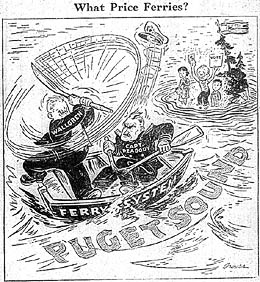On March 1, 1948, King County Ferry District No. 1 begins providing ferry service to and from Vashon Island. The district, created by the state legislature in response to angry Vashon Islanders' complaints over Captain Alexander Peabody’s shutdown of the privately owned Puget Sound Navigation Company, is the first and only (as of 2002) ferry district in the state of Washington. The district operates ferries for three years, until the creation of Washington State Ferries on June 1, 1951.
Prepared for the Worst
In March 1947, the Puget Sound Navigation Company (also known as the Black Ball Line) shut down for six days due to a ferry strike. At the time, Vashon Islanders had to scramble to find ways off the island, and many vowed that they would never suffer through such hardships again. They took action near the end of February 1948, when it became obvious that Captain Alexander Peabody was going to shut down the system on his own during his ongoing battle with government regulators.
Appealing to the state legislature, islanders secured the creation of King County Ferry District No. 1. When Peabody did indeed shut down the system on February 29, 1948, district commissioners George McCormick, Charles Law, and George Walls put their emergency service plan into action. On March 1, the passenger boat Gallant Lady began taking 45 passengers per run between Tahlequah and Tacoma.
Under an emergency order, the 45-car capacity Lincoln, which belonged to the county, was made available to the district. The Lincoln had served for years on Lake Washington, but had recently been taken off the run after construction of the Lake Washington Floating Bridge. On March 3, car service returned to the island between Vashon Heights and Fauntleroy.
Not an Easy Task
Rather than working with the state, Peabody approached the counties, offering them “bare boat charters,” lopsided agreements in which the Black Ball Line would receive all the advantages and the counties would receive all the liabilities. By March 9, 1948, regular services had started once again between King County and Kitsap County.
Vashon Islanders refused to make such an arrangement with Peabody, and continued running their own ferries instead. The passenger boat Elsie C replaced the Gallant Lady, and although there were concerns from the Coast Guard that the Lincoln was not seaworthy, the district patched it up enough for it to meet inspection.
Vashon Island ferry commissioners discovered that running a ferry system was not an easy task. Overloads were common, waits long. Some folks were nervous about riding the old Lincoln especially when light and water showed through the cracks in the decking and walls. Mass meetings were held to hear complaints, but most islanders preferred their ragtag system to going back under Peabody’s control.
Vashon Vigilantes
Peabody was not well-liked on the island. During the shutdown, an effigy of the Captain was hung from the ferry landing, and dangled in the air for some time afterward. Nevertheless, when Peabody heard the grumblings over the rough new service on the island, he made an attempt to reclaim the Vashon run under his system. He scheduled the Illahee to land at the Vashon dock on May 15, 1948.
Attorneys advised the Vashon ferry commissioners that if Peabody landed his ferry at the dock, then he might be within his rights to continue service to the island. Not wanting the competition, Islanders took matter into their own hands.
On the morning of May 15, a group of 25 men stood their ground at the end of the dock, armed with ax handles, billiard cues, hoes and other blunt instruments. The Illahee made attempts to land, but was thwarted by the vigilantes who pushed the boat back from the pilings. Unable to tie up, the vessel returned to Seattle, and the Islanders cried out in victory.
Three Years under the Mast
Peabody never made another attempt to reclaim the Vashon run. Instead, he battled the state for the next few years, as the state began setting up its own ferry system. Ultimately Peabody sold his fleet to the state, which began operating Washington State Ferries on June 1, 1951.
With the new state-run system in place, the Vashon directors turned in their commissions. They had run their own ferry service in the black for three years, but by this time were exhausted and more than happy to let the state take over.
Years later, George McCormick talked to the newspapers about the short-lived ferry district, and of the little island’s trials and tribulations of running a big cross-sound transit system. “It was a nightmare,” he said. “But, I can’t say we didn’t enjoy it.”

